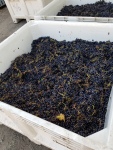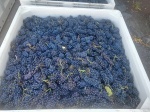Fifty Shades of Rose
Roses are red, and. never mind about the blue violets, we are talking about rose wine.
Most rose wines start as grapes with red pigment in their skins – Grenache, Sangiovese, Pinot Noir to name a few.
The winemaker takes an extra step (literally, more on that later) to gently crush them, so that the skin pigment begins to seep into the juice. The timing is precise and closely monitored, and when the correct tint has been achieved, off go the grapes to the press, squeezing that pink must (unfermented grape juice destined to become wine) away from the skins before it takes on too much color.
A little known fact is that all red wine is made from grapes with red skins and white interiors. The skin’s pigment colors the juice once the skins are broken, and red wine is then pressed after fermentation is over.
The exact hue of each rose, which means “pink” in French, is determined by the red grape variety and how long the skins sustained contact with the juices.
If red grapes are pressed immediately after harvest, the juice is separated from the skins very quickly before it has time to absorb color. The best known white wine made this way is Champagne, with each house using its own blend of Chardonnay (white), Pinot Noir (red) and Pinot Meunier (red) grapes.
Occasionally a rose is made from grapes that are not boldly red, but have some color in their skins. One of these, which myMEGusta tasted recently, was Rose of Gewurtztraminer, more of a novelty than a treat, truth be told.
On a recent visit to the David Hill Winery (https://www.davidhillwinery.com/) in Oregon’s Willamette Valley, myMEGusta stumbled upon an interesting crate of red Gamay grapes, before and after they were “galosh stomped”, the winemaker’s process for breaking the skins of red grapes destined to be rose. Note the difference in the volume before and after, when the juices were starting to run and the grapes starting to settle into the bin. Their destination soon after this photo was taken was to have that pink juice squeezed off into a fermentation tank.
Rose has always been a favorite of wine lovers, the traditional fine ones having been made by this painstaking process, and most of them quite dry, or fruity at best, never sweet.
Then came the Swingin’ Sixties and our friends from Portugal came out with Mateus and Lancers, happy little roses that had a touch of sweetness and zero complexity, perfect for neophyte young adults as starter wines (and, if our parents were not wine drinkers, them, too).
The White Zinfandel boom came a few years later, and rose became known as the wine for people who don’t like wine. All the rest of the roses, which had never changed from their original elegance, went swiftly out of fashion.
It has only been a few years since people have started realizing that a well-made rose is a delicious wine, particularly in the summer time, although the good ones stand beautifully alone as aperitifs and accompany good food all year round.





Love the story because I love Rose wines especially from the Rhone Valley in France. The Austrians have been making, drinking and celebrating wine since the Roman times and make in the province Steiermark as rose wine called Schilcher. Never hat a chance to taste it and it seldom leaves the area where it is made. So let’s celebrate with the huge selection of Rose wines on the store shelves.
I started drinking Rose this past summer and really enjoyed the light, refreshing taste. Hope we can toast a glass maybe spring or summer, here or there!
>